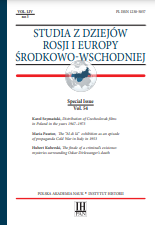Distribution of Czechoslovak films in Poland in the years 1947–1973
Distribution of Czechoslovak films in Poland in the years 1947–1973
Author(s): Karol SzymańskiSubject(s): Politics, WW II and following years (1940 - 1949), Post-War period (1950 - 1989), Film / Cinema / Cinematography
Published by: Instytut Historii im. Tadeusza Manteuffla Polskiej Akademii Nauk
Keywords: film distribution; cinemas in Poland; cinema roster; film on television; cultural policy of the Polish People’s Republic; Czechoslovak film;
Summary/Abstract: Szymański presents a fragment of the history of distribution of Czechoslovak films in Poland after the Second World War and analyses various forms and channels of their release. He also examines the representativeness of titles imported from Czechoslovakia and their position in the overall film range available to the citizens of a country in which the communist party held indivisible power and the state had a monopoly on all matters related to the production, marketing and rental of films. The article’s timeframe are the years 1947, which saw the premiere of the first Czechoslovak film purchased after the war, Men Without Wings by František Čap, and 1973, when the flagship works of “consolidated” and “normalised” Czechoslovak cinema began to appear on Polish screens after the fall of the Prague Spring, and Morgiana by Juraj Herz, considered to be the last masterpiece of the Czechoslovak New Wave, was introduced into circulation. Czechoslovak films were one of the most important components of the Polish cinema roster: 333 long- and medium-length works (feature, documentary and animated), which accounted for 8% of all premieres at that time, were introduced for distribution during the period under review. These films were displayed both in so-called large (regular) and limited circulation, i.e. restricted only to the network of film societes and arthouse cinemas. Works of Czechoslovak cinema could also be seen at various festivals and reviews (such as the annual Confrontations, and statewide Czechoslovak Film Festivals organised in the 1950s) and occasional screenings and solemn premieres (organised in celebration of the subsequent anniversaries of the ČSSR). Since 1958, Czechoslovak films were also permanently included in the programme of the Polish Television, which broadcast works both previously distributed in cinemas and exclusive premieres (including series since 1968) – purchased exclusively for television broadcasting (in the period under review: 93 titles).
Journal: Studia z Dziejów Rosji i Europy Środkowo-Wschodniej
- Issue Year: 54/2019
- Issue No: Sp.
- Page Range: 127-203
- Page Count: 77
- Language: English

